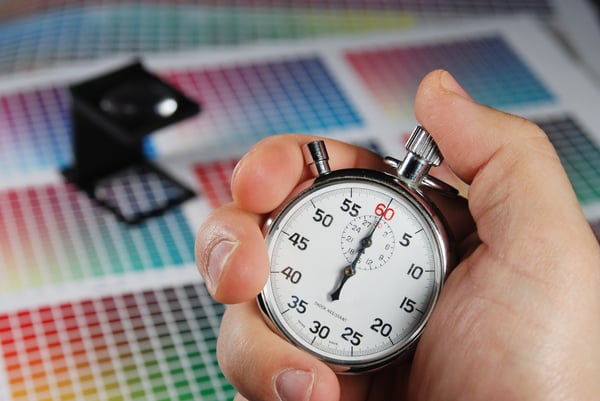Share this
5 Ways to Improve Flexo Packaging Printing Speeds
by Luminite on Jul 21, 2020 9:31:56 AM

You already know how important operational efficiency is, especially when it comes to optimizing your high-speed flexo press. The faster you can print, the more orders you can fulfill and the faster your customers can get their products on store shelves.
Fast time to market is important in any industry, but how can you achieve these fast speeds? How do you take your flexo packaging printing speeds to the next level without sacrificing quality? Here's a closer look at some ways to increase the feet per minute that you're able to print and ultimately add to your profits.
Increasing Flexo Packaging Printing Speed
As you know, when it comes to printing, a lot hinges on the efficiency of your equipment. Keeping your flexo press clean and oiled up can help get those rollers spinning faster. But there are a few other technical areas you can improve to get more out of your flexo printing operation.
Things to consider when looking to increase your printing speeds:
- Anilox roller alignment
- Substrate surface tension
- Image carriers: sleeves, cylinders, or plates
- Drying times and ink types
- Pressroom conditions
Let’s get into it, and we’ll make this speedy!
1. Anilox Roller Adjustments
You need quality anilox rollers for high speed commercial printers, period. But the rollers you're working with in the press itself can have a significant impact on how fast you're able to print.
It’s important to ensure you're selecting the right type of roll for the printing work you're performing. If you're printing with a lot of ink, you'll do best with a low-line roll.
If high definition is what you're striving for, a high-line roll is best. Make sure you know which roll works best with the speeds you're printing at and the type of print you’re looking to achieve.
2. Substrate Surface Tension
Sometimes it's the smallest adjustments that have the most significant impact on your packaging printing process. Take substrate surface tension, for example. When you increase surface tension, you accelerate drying times.
You'll just need to make sure you can increase the surface tension without sacrificing print quality. It can be a bit of a balancing act, but if you get it right, you'll be glad you put in the effort. The productivity gains can be significant.
ICYMI: We have a full guide here about flexo surface tension, energy, and wettability for more info.
3. Printing Sleeves
Elastomer sleeves, leveraging direct laser engraving technology, can help improve flexo printing speeds simply because these components can be quickly made, meaning that printing can start sooner.
Compared to conventional sleeve-making methods, which can have up to seven different stages before the sleeve even hits the printing press, a laser-engraved sleeve consists of only two steps. A laser engraved plate, similarly, consists of just three steps.
Not only are elastomer sleeves the quickest image carrier to make, they also last far longer than other conventional methods. You can run your presses longer, increasing your output significantly to meet your time-to-market goals.
4. Assess Your Pressroom Conditions
Sometimes a faster, more efficient print job doesn't have anything to do with the machine you're using. Sometimes, it's all about optimizing your pressroom conditions to accelerate drying times and efficiency.
For instance, if you're working with water-based flexo ink, you'll want to monitor the humidity in the pressroom. You'll also want to check that temperatures are right for better drying times. And make sure to set up the pressroom with proper ventilation and equipment to capture VOCs (volatile organic compounds). Safety first!
5. Don't Forget About Drying Times and Ink Types
Generally speaking, the higher the flexo press speed, the slower drying times need to be for a quality print job. However, this can be largely offset by working with an ink that can print at fast speeds while still maintaining overall form and stability.
Keep in mind what kind of ink you’re using and the customary drying times needed for said ink. Don’t rush to package a product and smear it because the ink wasn’t dry.
Get Those Numbers Up
While all of these tips and tricks can greatly improve your flexo printing speeds, do you know what won’t? Pesky printing defects.
They’re bound to happen -- every printer has woken up in a cold sweat thinking about misregistration or feathering.
But with this comprehensive guide to the most common flexo printing defects, you can set your mind at ease. Know what to watch for and how to fix it, and you’ll be able to set your machines to turbo mode and watch the prints fly off the press.
Share this
- Flexographic Printing (81)
- Image Carrier (28)
- Elastomer sleeves (27)
- Ink Transfer (25)
- Quality (22)
- Flexo sleeve (20)
- News (18)
- printing defects (18)
- flexo printing defects (17)
- sustainability (13)
- Flexo Troubleshooting (12)
- Ink (12)
- Digital Printing (10)
- Flexo 101 (10)
- Flexo Inks, (9)
- Anilox (7)
- Blister Packaging (7)
- Cost (6)
- print misregistration (6)
- regulations (6)
- Corrugated Printing (4)
- pinholing (4)
- "Tradeshow (3)
- Digital Flexo (3)
- Gravure Printing (3)
- Insider (3)
- Load-N-Lok (3)
- Wide Web (3)
- direct laser engraving (3)
- flexo-equipment-accessories (3)
- gear marks (3)
- halo (3)
- testing (3)
- Narrow Web (2)
- bridging (2)
- feathering (2)
- filling in (2)
- mottled image (2)
- pressure (2)
- Labelexpo (1)
- dirty prints (1)
- doughnuts (1)
- embossing (1)
- kiss impression (1)
- October 2023 (2)
- September 2023 (1)
- August 2023 (1)
- July 2023 (3)
- June 2023 (1)
- May 2023 (5)
- April 2023 (1)
- March 2023 (2)
- February 2023 (1)
- January 2023 (3)
- December 2022 (1)
- October 2022 (3)
- September 2022 (2)
- August 2022 (2)
- July 2022 (3)
- May 2022 (1)
- April 2022 (4)
- March 2022 (2)
- February 2022 (5)
- January 2022 (7)
- December 2021 (1)
- November 2021 (3)
- October 2021 (2)
- September 2021 (1)
- August 2021 (1)
- July 2021 (3)
- June 2021 (1)
- May 2021 (4)
- April 2021 (4)
- March 2021 (4)
- February 2021 (2)
- December 2020 (1)
- November 2020 (1)
- October 2020 (2)
- September 2020 (1)
- August 2020 (3)
- July 2020 (2)
- June 2020 (3)
- May 2020 (1)
- April 2020 (1)
- November 2019 (3)
- October 2019 (1)
- August 2019 (1)
- July 2019 (1)
- April 2019 (1)
- March 2019 (1)
- January 2019 (1)
- October 2018 (2)
- August 2018 (1)
- July 2018 (1)
- June 2018 (1)
- February 2018 (2)
- October 2017 (1)
- September 2017 (2)
- January 2016 (1)
- February 2015 (1)
- January 2015 (1)
- December 2014 (2)
- September 2014 (1)
- February 2014 (1)
- January 2014 (1)
- December 2013 (3)
- October 2013 (1)
- September 2013 (1)
- June 2013 (1)
- January 2013 (1)


Comments (1)